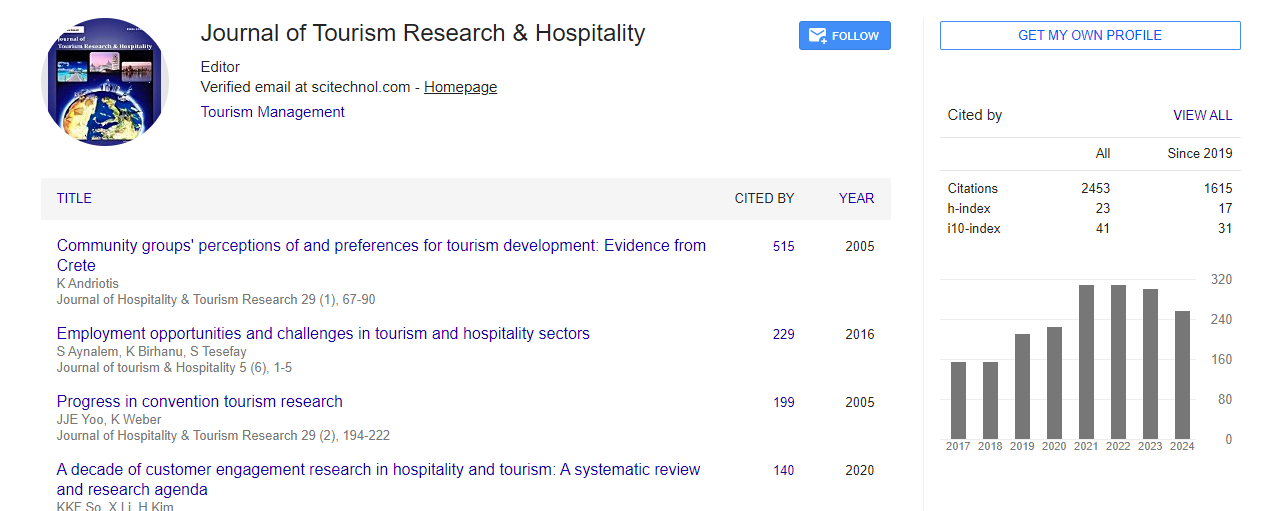Editorial, J Tourism Res Hospitality Vol: 10 Issue: 8
Hospitality Indicators Methodology
Howard Adler*
Department of Toursim, Princeton University, USA
*Corresponding Author:
Howard Adler
Department of Tourism Management,Princeton University, USA
Tel: +982161113646
E-mail: adlerh@purdue.edu
Received Date: August 13, 2019; Accepted Date: August 18, 2021; Published Date: August 25,2021
Citation: Adler H (2021) Hospitality Indicators Methodology. J Tourism Res Hospitality 10:8. e116.
Copyright: © All articles published in Dental Health: Current Research are the property of SciTechnol, and is protected by copyright laws. “Copyright © 2021, SciTechnol, All Rights Reserved.
Keywords: Hospitality Indicators
A city can go about as a host to different visitors, incorporating its own in-habitants, guests, and travelers. Urban communities can likewise be assessed as far as the degree of welcome they offer their guests. It is additionally recognized that objections can be decided by a basis of neighborliness fixated on causing visitors to feel appreciated. Voyagers have consistently confronted the viable issues of discovering food and sanctuary in a new climate, prompting the thousand years old marvel of neighborliness . Aside from inviting, the idea of neighborliness has different layers of importance, like giving help and insurance to voyagers. Accommodation addresses an omnipresent human conduct planned to ensure and respect guests, which is a general practice of human culture.
According to an anthropological viewpoint, feelings of accommodation lies in lessening the strain in have visitor experiences through minimizing the host’s apprehension about outsiders and the visitor’s interest of others. An ordinary perspective on cordiality focuses on offering the guest a feeling of home. This view might be addressed as a guest regularly leaves behind locally established schedules, looking for oddity and distinction. The idea of friendliness has been embraced to portray the commercial exercises for getting visitors, including the areas of accommodation, food, and refreshment. Insightful consideration has zeroed in on business friendliness, neglecting cordiality in the private and social areas. In the sociologies, the idea of neighborliness has undertones that go past business benefits and incorporates social communication and connections. Private and social friendliness examinations have been more uncommon than business cordiality.
Urban areas or spots can instigate guests and inhabitants’ sentiments dependent on close to home encounters. Such sentiments, temperament, or slant toward objections depend on the cordiality advertised. A city can be viewed as a host to a wide cluster of visitors, including guests and van der Rest. In any case, the exhibition of the host has only from time to time been assessed in spite of the way that every objective is anxious to introduce an accommodating picture of the spot or its kin (Lugosi, 2016). Consequently, this investigation tends to an examination hole through the utilization of a comprehensive way to deal with evaluate an objective’s neighborliness, to be specific, the degree to which they invite travelers. This examination has zeroed in on the commitment of human (practices and environment) and nonhuman variables (foundation) to the friendliness of the objective. The investigation has created Prooijen and Wiegerink’s idea of city hospitality. The outcomes give a plausible device to estimating an objections’ exhibition to grandstand accommodation in the three components of conduct, framework, and feel.
The environment measurement incorporated some human components, yet not identified with conduct. This measurement identifies with the general environment and feeling made by the objective. The environment has a course on vacationers’ pleasure in the location’s attractions and conveniences. Objective or the travel industry environment affects visit judgment of the degree to which they feel invited by a spot. Top three pointers of each component of objective neighborliness. * The two things on data and transport had the very mean score as that of sign, with a lower level of sufficiency.
Diary of Destination Marketing and Management highestscored thing of the climate order was wellbeing and security. This is justifiable as shielding sightseers from likely risks or dangers is a basic component of neighborliness .Board individuals prescribed an additional factor as to security to incorporate the wellbeing of ladies. This factor ought not to be eclipsed by generally security as the wellbeing of ladies identifies with explicit concerns identifying with female sightseers.Markers identifying with segregation and fights against vacationers follow wellbeing, and aggression toward travelers in mass/web-based media. The shortfall of these three elements in an objective shows its neighborliness, the presence of segregation, fights, and antagonism exhibits inhospitality. These elements are viewed as the essential necessities for objective accommodation as vacationers reserve an option to be treated without aggression inside a country.
This examination recognized 28 markers for the three elements of objective neighborliness: accommodating practices, foundation and hard-product, and climate and feeling. The foundation of pointers of objective cordiality makes ready for the appraisal of objective neighborliness. Objective administration associations and the travel industry authorities might utilize these pointers to look at and work on the hospitality of their objective. Such endeavors would help objective promoting and upgrade vacationer experience by validating location friendliness.
 Spanish
Spanish  Chinese
Chinese  Russian
Russian  German
German  French
French  Japanese
Japanese  Portuguese
Portuguese  Hindi
Hindi 

